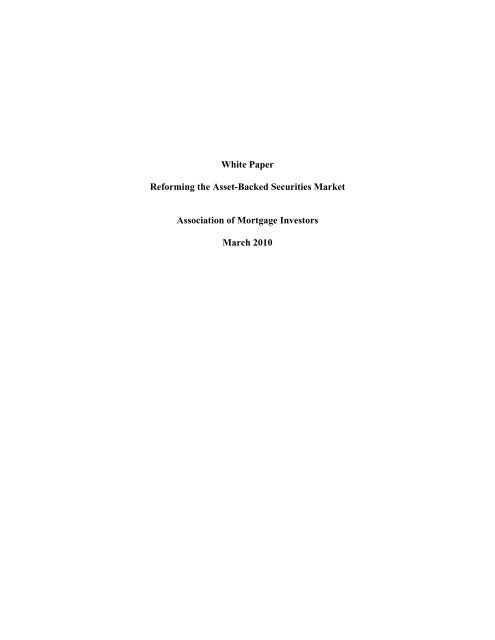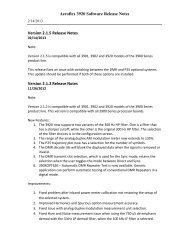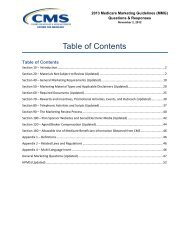White Paper Reforming the Asset-Backed Securities Market - The AMI
White Paper Reforming the Asset-Backed Securities Market - The AMI
White Paper Reforming the Asset-Backed Securities Market - The AMI
You also want an ePaper? Increase the reach of your titles
YUMPU automatically turns print PDFs into web optimized ePapers that Google loves.
<strong>White</strong> <strong>Paper</strong><br />
<strong>Reforming</strong> <strong>the</strong> <strong>Asset</strong>-<strong>Backed</strong> <strong>Securities</strong> <strong>Market</strong><br />
Association of Mortgage Investors<br />
March 2010
Introduction<br />
In <strong>the</strong> two and a half years since <strong>the</strong> financial crisis began, it has become clear that <strong>the</strong><br />
continued health of <strong>the</strong> securitization markets is crucial not just to U.S. economic recovery but to<br />
<strong>the</strong> financial system as a whole. <strong>The</strong>re are three sources of residential and commercial mortgage<br />
capital in <strong>the</strong> United States – bank balance sheets, which are full and stressed; <strong>the</strong> securitization<br />
market, which is effectively shut down; and <strong>the</strong> government (Fannie Mae, Freddie Mac, FHA,<br />
etc.). For o<strong>the</strong>r types of debt capital, <strong>the</strong>re are only two sources – banks and <strong>the</strong> securitization<br />
market – as <strong>the</strong> government does not directly provide capital <strong>the</strong> way it does for mortgages.<br />
Restoring <strong>the</strong> securitization market is necessary to get more private capital flowing to those who<br />
wish to use it, and accordingly to reduce <strong>the</strong> government’s role of providing public capital to,<br />
and allocating that capital among, private borrowers.<br />
<strong>The</strong> structures and mechanisms that have defined <strong>the</strong> securitization market to date have<br />
been constructed by issuers, underwriters, credit rating agencies and asset servicers with minimal<br />
disclosure-based, procedural or substantive regulation by Congress, financial regulators or <strong>the</strong><br />
SEC. Investors provide <strong>the</strong> capital that make <strong>the</strong> securitization markets work yet have been<br />
ignored in market structure discussions. <strong>The</strong>y have been told by o<strong>the</strong>r parties to securitization to<br />
“take it or leave it” on disclosures, definitions and structures, in o<strong>the</strong>r words - “just buy <strong>the</strong><br />
securities we offer you”. Now that poor credit underwriting, moral hazards, inadequate<br />
disclosures, asset servicer conflicts of interest, ratings agency failures, and logistical obstacles to<br />
working out bad collateral assets have scared investors away from <strong>the</strong> securitization markets, it is<br />
important for <strong>the</strong> government to consider <strong>the</strong> policy recommendations of investors, whose<br />
participation and capital are needed for <strong>the</strong>re to be an asset-backed securities market at all. In<br />
fact, while issuers suggest o<strong>the</strong>rwise and ideally it would be great if a consensus between issuers<br />
and investors could emerge, <strong>the</strong>re need not be a consensus as investors ultimately provide <strong>the</strong><br />
capital and have <strong>the</strong> responsibility to define <strong>the</strong> terms on which <strong>the</strong>y will commit <strong>the</strong>ir capital.<br />
We believe that <strong>the</strong> following recommendations support healthy and efficient markets,<br />
with more information made more widely available to participants, regulators and observers;<br />
incentivize positive economic behavior among market participants; reduce information<br />
asymmetries that distort <strong>the</strong> spread between price and value and are entirely consistent with <strong>the</strong><br />
government’s traditional roles of standard-setting in emerging capital markets.<br />
1. Provide loan-level information that investors, ratings agencies and regulators can<br />
use to evaluate collateral and its expected economic performance, both at pool<br />
underwriting and continuously over <strong>the</strong> life of a securitization. Currently loan-level financial<br />
and related due diligence information is not required to be publicly disclosed. Issuers,<br />
underwriters and asset servicers already have this information and it costs little to make it<br />
publicly available on EDGAR or similar systems. Investors in asset-backed securities have both<br />
<strong>the</strong> interest and <strong>the</strong> ability to analyze such information to help <strong>the</strong>m make better purchase and<br />
sale decisions relating to asset-backed securities.<br />
Data should be provided on a daily, or at least monthly, basis in both <strong>the</strong> primary and<br />
secondary markets. To ensure adequate transparency, enhanced disclosure rules should be<br />
required both for deals with and without static pool data such as asset-backed commercial paper.<br />
Data on <strong>the</strong> specific underlying collateral in each pool should be made available for a reasonable<br />
period – not less than two weeks – before a deal is sold and brought to market. This should be
done to enhance investor due diligence, to foster <strong>the</strong> development of independent analytical data<br />
providers, and to reduce reliance on rating agencies. To ensure <strong>the</strong> accuracy of <strong>the</strong> information,<br />
loan-level data offered by issuers, underwriters or assets servicers for investors should be<br />
accompanied by an auditor attestation verifying that <strong>the</strong> data has been properly aggregated,<br />
calculated and published. <strong>The</strong> loan-level data should be available in an electronically<br />
manageable and industry standardized format. After <strong>the</strong> deal is sold, all data fields in <strong>the</strong> preissuance<br />
disclosures and material information about <strong>the</strong> loan-level collateral in <strong>the</strong> pool should<br />
be updated and be similarly disclosed on a daily, or at least monthly, basis. <strong>The</strong> data already<br />
exists and <strong>the</strong> creation of standard data fields and automation of this process would create little<br />
regulatory burden.<br />
Capital markets would be less volatile if investors could fully model <strong>the</strong> expected<br />
performance of underlying loan-level collateral before a deal comes to market and, on a regular<br />
basis, assess <strong>the</strong> deviance from expectations. <strong>The</strong> provision of loan-level performance to<br />
investors on a regular basis would allow any degradation of performance to be observable and<br />
<strong>the</strong>refore priced in over incremental periods. By requiring that investors receive early and<br />
regular disclosures of all available information about collateral performance, <strong>the</strong> importance of<br />
NRSROs’ ratings will be diminished to <strong>the</strong> level of equity analysts’ research notes.<br />
<strong>The</strong> fact that investors have to pay to subscribe to services such as Loan Performance to<br />
get data on collateral underlying asset-backed securities <strong>the</strong>y are offered and may already hold is<br />
outrageous in light of <strong>the</strong> no-cost extensive public disclosure required for corporate securities.<br />
Arguments that <strong>the</strong> amount of loan-level information exceeds <strong>the</strong> capacity of investors to process<br />
and analyze – when issuers, underwriters and asset servicers have no problem processing and<br />
analyzing <strong>the</strong> very same data – are absurd on <strong>the</strong>ir face.<br />
2. Require a “cooling off” period when asset-backed securities are offered so that<br />
investors have sufficient time to review and analyze loan-level information before making<br />
investment decisions. Currently investors in primary offerings of asset-backed securities are<br />
forced to make decisions as to whe<strong>the</strong>r or not <strong>the</strong>y want to purchase immediately after deals<br />
come to market. As with existing SEC requirements relating to new issues of equity and debt<br />
securities, issuers should have to wait for a reasonable period of time before closing offerings of<br />
asset-backed securities. A two-week period would permit investors to properly analyze loanlevel<br />
collateral and independently determine whe<strong>the</strong>r projected performance expectations are<br />
adequate.<br />
3. Make deal documents for all asset-backed securities and structured finance<br />
securities publicly available to market participants and regulators. This will substantially<br />
increase market liquidity for such securities after <strong>the</strong>y are sold. In <strong>the</strong> lead-up to <strong>the</strong> financial<br />
crisis, even primary financial regulators could not analyze or even have access to deal documents<br />
of asset-backed and structured finance securities (e.g. CDOs) that <strong>the</strong>ir regulated institutions<br />
held. <strong>The</strong> common practice of making fundamental asset-backed and structured finance deal<br />
documents proprietary and subject to confidentiality obligations is fundamentally inconsistent<br />
with properly functioning capital markets and prudential regulation of financial institutions.
4. Develop, for each asset class, standard pooling and servicing agreements with model<br />
representations and warranties as a non-waivable industry minimum legal standard. Right<br />
now every pooling and servicing agreement for a securitization is custom-written.<br />
Representations and warranties vary tremendously from deal to deal, even within <strong>the</strong> same<br />
fundamental asset class (mortgages, credit cards, etc.). This requires investors to spend<br />
tremendous amounts of time analyzing <strong>the</strong> differences between different transactions’ legal<br />
terms and subjectively weighing <strong>the</strong> economic meaning of those terms before coming to<br />
investment decisions – or alternatively to ignore <strong>the</strong>se differences of legal terms in <strong>the</strong> interest of<br />
time, to <strong>the</strong> peril of investors when problems develop in <strong>the</strong> market.<br />
This lack of standardization and <strong>the</strong> length of <strong>the</strong> legal documentation effectively created<br />
opacity in <strong>the</strong> securitization market, which substantially contributed to <strong>the</strong> recent problems<br />
experienced by market participants. When collateral pool performance deteriorated, panic set in<br />
and investors began to question <strong>the</strong> value of <strong>the</strong>ir securities, <strong>the</strong>y knew that <strong>the</strong>y did not have <strong>the</strong><br />
time to read all of <strong>the</strong> different several-hundred-page deal agreements to evaluate <strong>the</strong>ir holdings.<br />
This reinforced <strong>the</strong> rush to liquidate positions. What investor wants to be <strong>the</strong> last one holding a<br />
security <strong>the</strong> terms of which he doesn’t fully understand? Potential buyers of <strong>the</strong>se securities in<br />
turn would not step into <strong>the</strong> market without having read <strong>the</strong> documents <strong>the</strong>mselves, causing <strong>the</strong><br />
entire fixed-income market worldwide to freeze up.<br />
Standardizing legal documentation gives investors a common framework with which to<br />
evaluate <strong>the</strong>ir potential and actual holdings of asset-backed and structured finance securities<br />
based largely if not solely on collateral pool performance. <strong>The</strong> asset-backed securities market as<br />
a whole would <strong>the</strong>reby become more homogenous and <strong>the</strong>refore more liquid. Investors should<br />
be able to rely on certain baseline assurances as to <strong>the</strong> nature of <strong>the</strong> collateral underlying <strong>the</strong>ir<br />
securities. Having a single standard set of representations and warranties that must be met or<br />
exceeded in every transaction gives investors comfort about <strong>the</strong> assets in which <strong>the</strong>y have an<br />
interest, and reduces <strong>the</strong> overhead costs of investing in <strong>the</strong>se securities. In addition, standardized<br />
representations and warranties would streamline resolution of disputes as to whe<strong>the</strong>r<br />
representations and warranties are met by individual assets within collateral pools.<br />
Model agreements for <strong>the</strong> asset-backed securities market should be drafted with <strong>the</strong> best<br />
interests of <strong>the</strong> investing public, and with clarity of rights and responsibilities, at <strong>the</strong>ir cores.<br />
5. Develop clear standard definitions for securitization markets. Without a common<br />
language and agreement on <strong>the</strong> meanings of fundamental concepts – such as “delinquency” and<br />
“default” – <strong>the</strong> value of data is diminished, <strong>the</strong> ability to compare securities across different<br />
pools is diminished, and <strong>the</strong> concepts of relative collateral pool performance and economic value<br />
become seriously muddied. <strong>The</strong>re are no such standard definitions currently, and as a result<br />
servicers with very similar underlying collateral pools and servicing standards can produce<br />
radically different reports of collateral performance. For example, <strong>the</strong> term “delinquency” can<br />
be determined ei<strong>the</strong>r on a contractual or recency-of-payment basis. Even among firms that<br />
would define delinquency on <strong>the</strong> same basis, each servicing agreement can have different<br />
interpretations on reporting of delinquencies – some may report advances that a servicer makes<br />
to a pool that could be applied to reduce stated delinquencies, but o<strong>the</strong>r servicing agreements<br />
may not. When no one agrees on what delinquencies are and how <strong>the</strong>y must be reported, <strong>the</strong>n<br />
how do we know what <strong>the</strong> term “default” means? How can anyone really understand what is<br />
happening if <strong>the</strong>re is so much variability deal-to-deal and <strong>the</strong>re are no industry-standard
practices? This is a huge problem that interferes with investors’ ability to make investment<br />
decisions among various deals and issuers. <strong>The</strong> lack of clear standard definitions reinforces <strong>the</strong><br />
complexity from <strong>the</strong> lack of standard contracts in securitization deals, and also makes it harder<br />
for capital markets to function.<br />
Conversely, if everyone is using common language in loan origination and securitization<br />
<strong>the</strong>n it becomes very hard to game <strong>the</strong> system as issuers and servicers have.<br />
6. Directly address conflicts of interest of servicers that have economic interests<br />
adverse to those of investors, by imposing direct fiduciary duties to investors and/or<br />
mandatory separation of those economic interests, and standardize servicer accounting and<br />
reporting for restructuring, modification or work-out of collateral assets. Servicers of<br />
mortgage or o<strong>the</strong>r financial asset pools often have economic interests that differ from those of<br />
investors. Simple contracts between servicers and securitization trustees, which <strong>the</strong>mselves are<br />
subject to little or no accountability to investors, have not sufficiently aligned <strong>the</strong> interests of<br />
servicers to those of investors over time.<br />
Where servicers are charged with enforcing representation and warranty claims on<br />
specific collateral pool assets so <strong>the</strong>y are put back to originator affiliates of <strong>the</strong> servicers at par,<br />
<strong>the</strong> servicers have a conflict of interest and appear to have been delaying in carrying out such<br />
put-backs so as to avoid losses to <strong>the</strong>ir affiliates. Where servicers have affiliates that hold<br />
second lien or mortgage pool residual interests, <strong>the</strong>y appear to have been carrying out <strong>the</strong>ir loss<br />
mitigation duties in ways that delay resolution and <strong>the</strong>reby maximize <strong>the</strong> option value of such<br />
second lien or residual interests, often at <strong>the</strong> direct expense of <strong>the</strong> senior tranche holders.<br />
Investors in asset-backed securities need to know that servicing is being performed in a way that<br />
maximizes <strong>the</strong> present value of <strong>the</strong> entire collateral pool without regard to such conflicts, and this<br />
can only be done if fiduciary duties flow directly from servicers that are sufficiently kept away<br />
from such competing economic interests.<br />
Servicers, securities administrators and trustees must also establish and enforce uniform<br />
accounting policies and procedures for loan restructurings. Since <strong>the</strong> existing securitization<br />
contracts did not contemplate <strong>the</strong> scope and economic impact of <strong>the</strong> modifications being<br />
implemented under today’s environment, it is imperative that securitization accounting in <strong>the</strong><br />
future reflects <strong>the</strong> actual economic impact of <strong>the</strong> modified cash flows associated with <strong>the</strong><br />
restructuring. Where loan modifications involve principal forbearance, <strong>the</strong>re must be recognition<br />
of economic losses that affect how cash flows are allocated within securitizations.<br />
7. Just as <strong>the</strong> Trust Indenture Act of 1939 requires <strong>the</strong> appointment of a suitably<br />
independent and qualified trustee to act for <strong>the</strong> benefit of holders of corporate debt<br />
securities, model securitization agreements must contain substantive provisions to protect<br />
asset-backed security holders. Right now, trustees of collateral pools play a largely passive<br />
role and bear little if any accountability to <strong>the</strong> holders of securities which <strong>the</strong>y have agreed – and<br />
are being compensated – to serve. In practice <strong>the</strong>y do not supervise <strong>the</strong> servicers of collateral<br />
pools, who are often affiliated with <strong>the</strong> loan originators and <strong>the</strong>refore have strong incentives not<br />
to enforce representation and warranty claims on behalf of investors. Trustees have no practical<br />
means of monitoring or reacting to servicer performance, and no incentive to do so.
If one considers that <strong>the</strong> trustee of a securitization is like <strong>the</strong> board of directors of a<br />
company and <strong>the</strong> servicer of a collateral pool is functionally like <strong>the</strong> management, <strong>the</strong>n it must<br />
be stated that holders of asset-backed securities are not given <strong>the</strong> protective rights, relative to<br />
those expected to serve <strong>the</strong>m, that shareholders are provided. Securitization legal structures may<br />
utilize trustees and holders of asset-backed securities may have <strong>the</strong>ir rights shaped by contracts,<br />
but <strong>the</strong>se holders are collectively <strong>the</strong> equity of <strong>the</strong> trust and <strong>the</strong>y are owed fiduciary duties which<br />
must be respected. At least shareholders have <strong>the</strong> right to find out who <strong>the</strong>ir fellow security<br />
holders are, <strong>the</strong> right to an annual meeting, and <strong>the</strong> right to remove and elect new directors.<br />
Holders of asset-backed securities have none of <strong>the</strong>se rights.<br />
Given servicer incentives and conflicts of interest, <strong>the</strong> only effective way to effectively<br />
enforce deal representations and warranties back to <strong>the</strong> originator or sponsor is to give investors<br />
<strong>the</strong> ability to re-underwrite <strong>the</strong> loans as per initial collateral guidelines. Current private-market<br />
ABS legal structures seriously limit investors’ access to data and ability to require put-backs of<br />
bad collateral by onerous minimum ownership hurdles and legal procedures. Legal rights to <strong>the</strong><br />
integrity of pool collateral without a practical means of enforcement are meaningless in practice,<br />
both as a deterrent to originators’ knowingly dumping bad assets into ABS pools and as a<br />
remedy to investors harmed by such practices.<br />
8. <strong>Asset</strong>-backed securities should be explicitly made subject to private right of action<br />
provisions of anti-fraud statutes in securities law and to appropriate Sarbanes-Oxley<br />
disclosures and controls. Just as <strong>the</strong>se legal provisions extend to equity and debt securities and<br />
help to support investor confidence that <strong>the</strong>y are being treated fairly by issuers, <strong>the</strong>y should<br />
similarly extend to asset-backed securities.<br />
9. Certain asset-backed securities could be simplified and standardized so as to<br />
encourage increased trading in <strong>the</strong> secondary market on venues, such as exchanges, where<br />
trading prices are more visible to investors and regulators. This could result in better price<br />
discovery, additional market transparency, additional liquidity and reduced bid/ask spreads. In<br />
<strong>the</strong> interim, investors should be strongly encouraged to buy only those financial instruments<br />
which <strong>the</strong>y have an understanding of and are able to analyze completely, including <strong>the</strong><br />
instruments’ current market value. All dealers should be required to disclose historical trade<br />
prices on <strong>the</strong>se simplified and standardized asset-backed and structured finance securities daily.<br />
10. Ratings agencies need to use loan-level data in <strong>the</strong>ir initial ratings and to update<br />
<strong>the</strong>ir assumptions and ratings as market conditions evolve and collateral performance is<br />
reported. <strong>The</strong> poor record of recently issued asset-backed securities, in light of high initial<br />
ratings which were infrequently if at all updated as collateral performance came in, shows that<br />
we need fundamental change in <strong>the</strong> ratings process.<br />
Rating agencies should have to base initial ratings on loan-level data with publicly<br />
disclosed economic and collateral performance assumptions including a life-loss curve. As time<br />
goes on, <strong>the</strong>y should be required to update <strong>the</strong>ir models periodically with updated economic<br />
assumptions and new monthly remittance data from servicers. <strong>The</strong>re should be regular<br />
secondary market re-ratings, frequent and timely enough to be of real use to investors. Each
NRSRO should have an independent office of a chief statistician that would archive and update<br />
ratings models firm-wide, and should be paid based on <strong>the</strong> accuracy of <strong>the</strong>ir ratings as collateral<br />
performance is reported. Rating agencies should have <strong>the</strong>ir liability exemptions carved back,<br />
should have minimum industry standards for analyst professional training in structured finance,<br />
and should prohibit revolving-door employee moves to issuers and underwriters. (Of course<br />
analysts should be able to join investor firms after leaving <strong>the</strong> rating agencies as <strong>the</strong>re is not <strong>the</strong><br />
same conflict of interest as with issuers and underwriters.)<br />
We should create financial and reputation-based incentives for rating agencies to utilize a<br />
regular loan-level and cash flow approach to re-rating securities on a regular and frequent basis<br />
and <strong>the</strong>ir income should be specifically tied to <strong>the</strong> performance of <strong>the</strong> rated securities over <strong>the</strong><br />
life of <strong>the</strong> issue.<br />
Conclusion<br />
Securitization has shifted significant funding for many asset classes away from bank<br />
balance sheets and into <strong>the</strong> hands of capital markets participants. With appropriate standards and<br />
rights for <strong>the</strong> holders of asset-backed securities, securitization would more efficiently fund<br />
markets, result in less volatility, and produce a better convergence between <strong>the</strong> pricing and value<br />
of assets in support of economic activity. This is <strong>the</strong> reason that we must now restart <strong>the</strong><br />
securitization markets. If <strong>the</strong>se markets are not functioning as an alternative to portfolio lending<br />
where economically less expensive, <strong>the</strong>n <strong>the</strong>re is no way to finance an economy that has<br />
previously been funded by global capital flows.<br />
Given <strong>the</strong> problems in <strong>the</strong> securitization market that have been exposed by <strong>the</strong> financial<br />
crisis, if <strong>the</strong> fundamental market restructuring steps taken above are not taken <strong>the</strong>n it will be<br />
difficult if not impossible for capital market investors to return to funding economic activity to<br />
<strong>the</strong> degree that <strong>the</strong>y did previously.









